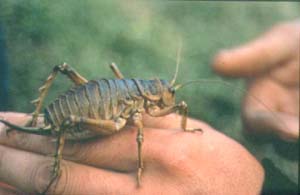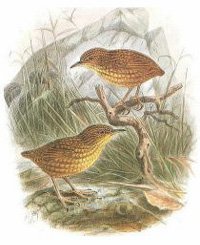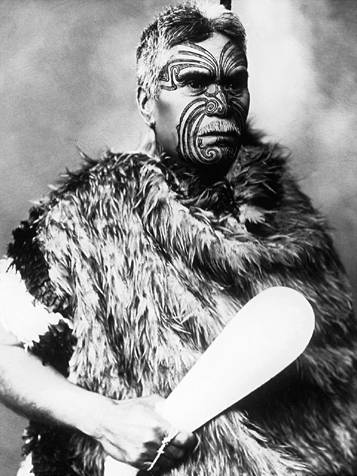New
Zealand
provides a manageable case study of the process of
ecological
transformation--the creation of a neo-Europe
historians don't just make generalizations, they look at how the story unfolds in a particular time and place
how do you decide any given example is typical? or do you want to use an extreme example because it highlights the issues
It was particularly unique because of its extreme isolation
one way to think about an ecosystem is as a series of niches--ecological opportunities
what fills these niches if the usual animals aren't there?

 A
flightless
songbird--one of only three flightless songbirds ever known
and the world's smallest
A
flightless
songbird--one of only three flightless songbirds ever known
and the world's smallest
the largest flightless birds, the moas, filled the niche of grazing animals

All 11 species of Moa were hunted to extinction by the Maori in the 13th and 14th century. They only laid one or two eggs at a time and took 10 years to grow to maturity so were wiped out easily.
"Second only in weight to the extinct elephant bird of Madagascar, the largest moa was the tallest bird on earth, with the top of its' back 6 feet above the ground" (source)
The largest Moa still weighed over 500 lbs. They ate mostly bushes and the lower branches of trees. Their beaks were strong, able
The Haast's eagle, with wingspan of 3 meters, preyed on the Moa and died out with it

The environment needed to be transformed to make it appealing to European settlers

Maori adopted European ways with enthusiasm (more Maori history)

historians don't just make generalizations, they look at how the story unfolds in a particular time and place
how do you decide any given example is typical? or do you want to use an extreme example because it highlights the issues
It was particularly unique because of its extreme isolation
- 89% of native plants are endemic (exist nowhere else in the world)
- many familiar
kinds of animals were
missing and other animals had taken those niches
- before the
aborigines
(Maori) arrived there were no land mammals but
the bat (therefore birds took many of the ecological
niches usually
taken by mammals--for example, the only large grazing
animals were
birds)
- also the culture of the people was unusual
one way to think about an ecosystem is as a series of niches--ecological opportunities
what fills these niches if the usual animals aren't there?

giant
weta
an insect that takes the ecological niche of a mouse--
unfortunately cats think them great entertainment
Another animal filling the
niche
of the mouse was the Stephens Island Wrenan insect that takes the ecological niche of a mouse--
unfortunately cats think them great entertainment
 A
flightless
songbird--one of only three flightless songbirds ever known
and the world's smallest
A
flightless
songbird--one of only three flightless songbirds ever known
and the world's smallest- Lived on a one
square mile
island off the northern tip of the South Island--a
remnant of the
ecosystem as it had been before the Maori brought with
them rats
- "It was only seen
live on
two occasions when it was disturbed from holes in rocks.
It was thought
to have been semi nocturnal and ran very fast like a
mouse." (source)
- At the Ornithologists Club in London in 1894 a collector proudly displayed 10 specimens of the wren that had been killed by the lighthouse keeper's cat
- He also announced
that the
species was now extinct due to the cat
the largest flightless birds, the moas, filled the niche of grazing animals

All 11 species of Moa were hunted to extinction by the Maori in the 13th and 14th century. They only laid one or two eggs at a time and took 10 years to grow to maturity so were wiped out easily.
"Second only in weight to the extinct elephant bird of Madagascar, the largest moa was the tallest bird on earth, with the top of its' back 6 feet above the ground" (source)
The largest Moa still weighed over 500 lbs. They ate mostly bushes and the lower branches of trees. Their beaks were strong, able
The Haast's eagle, with wingspan of 3 meters, preyed on the Moa and died out with it

The environment needed to be transformed to make it appealing to European settlers
- the climate was suitable
- they set out to
change the
ecosystem
- the Maori took up growing potatoes, giving them something to trade with Europeans
- pigs went wild quickly and the population grew
- some weeds (white
clover)
couldn't spread without insect pollination--bees were
brought in 1839
- you couldn't have a
lot of
grazing animals until European grasses spread
- some more organized societies almost immediately saw the Europeans as a threat
- some people weren't very interested in what the Europeans brought
- the Maori were
different--not technologically sophisticated but well
organized and
open to new ideas, had a culture based on warfare

Maori adopted European ways with enthusiasm (more Maori history)
- the Maori grew cash crops and raised pigs to sell the the Europeans
- they wanted iron tools and axes and muskets for inter-tribal warfare
- Europeans sold them large numbers of guns
- they weakened themselves by fighting among themselves
- missionaries introduced the plow in 1820
- they learned quickly
from
the Europeans, even building mills to grind the grain
they had stated
to grow
- few bacteria that affect humans had made it to New Zealand
- their culture didn't know how to cope with disease
- diseases like
smallpox and
measles got there slowly because it was such a long ship
journey the
disease didn't get there at first
- their culture made them vulnerable to venereal disease--practices of sexual hospitality
- venereal diseases
reduce
the birth rate
- In the early 1800s the Maori embraced Christianity and literacy
- (European technology
was
equivalent to magic so must have something to do with
religion)
- Maori attempts to copy the Europeans and meet them as equals didn't stop the Europeans from stealing their land
- they ignored the claims of the native people or took advantage of different understandings of land ownership
- "Traditional Māori society did not have a concept of absolute ownership of land. Whānau (extended families) and hapū (sub-tribes) could have different rights to the same piece of land. One group may have the right to catch birds in a clump of trees, another to fish in the water nearby, and yet another to grow crops on the surrounding land. Exclusive boundaries were rare, and rights were constantly being renegotiated." (source)
- the 1862
Native
Land
Act sought to assign individual ownership to Maori
land
so it could be readily traded
- side note:
- our modern American system of land ownership is quite unusual
- if you own land you can do anything you want with it
- in other places you often had only partial rights to land (even today)
- many limits on
what you
can do with your land
- Maori tried to meet
the
Europeans as equals and were cheated
- eventually in the 1850s the Maori resorted to war, and were smart enough to work together
- but already they were already outnumbered by settlers and couldn't sustain the fight
- by 1870 only 1/5 the population were Maori

Europeans
took control of the land by force
- Europeans had developed the expectation that they could replace the native people
- in North and Central America disease was the largest factor
- sometimes
ecology played as
large a role
- they succeeded where they had an ecological advantage, as in New Zealand
- they changed the
ecosystem
from the native one to a European one
- in South Africa Europeans had a bigger cultural advantage, but they failed because they didn't have an ecological advantage
- warfare, disease and changing the ecology were parts of how the Europeans succeeded almost everywhere, but the balance varied from place to place
- Europeans had biological advantages that allowed them to take over
- Why?
- they were already resistant to the diseases they brought with them
- the places they went to had few diseases because of isolation
- Europe had many diseases because they spread over a large land mass, dense population, and many domestic animals
- sheer numbers--Europeans settled and compromised with the indigenous people until their increase and the the decrease in the native population caused by diseases gave them the advantage
- changed the ecosystem to one that suited them
- Europeans wouldn't want to settle unless they could have familiar plants and animals
- they would have had a harder time feeding themselves if they had been dependent on native plants and animals
- the spread of European plants and animals may have put the Maori at a disadvantage
- as well as
biological
advantages, Europeans
had technological advantages--particularly over
cultures like the Maori
that didn't have metal. Also Europeans had a
government and
economic system suited for taking control of other
people's land